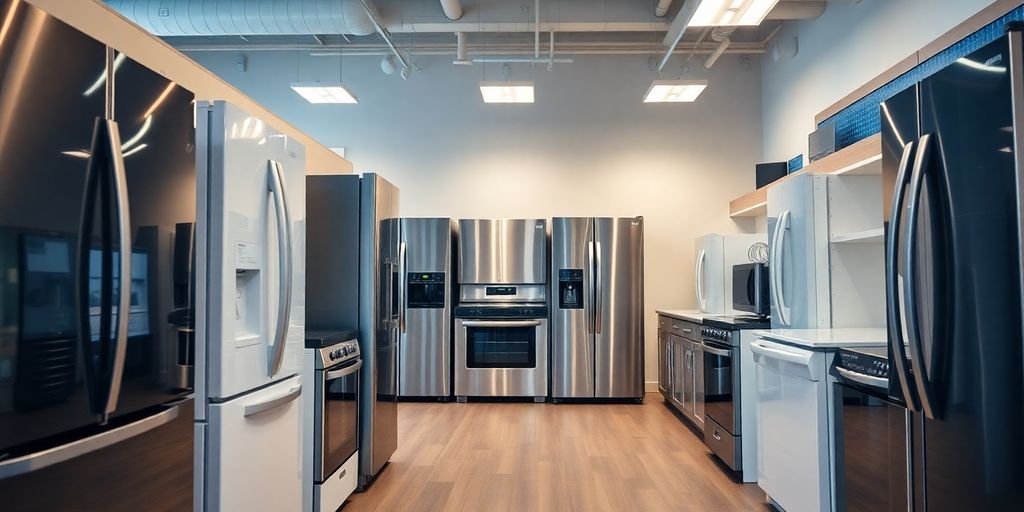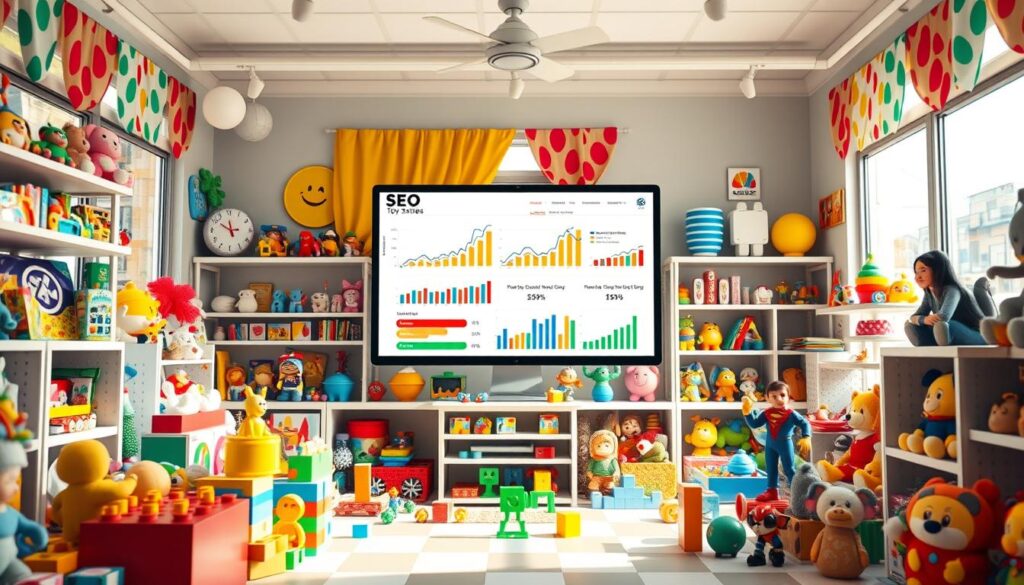Ever wondered what SEO is all about for appliance stores? It’s a game-changer. SEO, or search engine optimization, is what helps your store show up when folks search online for appliances. If you’re not on the first page of search results, you’re missing out big time. This guide will walk you through the ins and outs of SEO, why it’s crucial for local visibility, and how to nail the right strategies to get your store noticed.
Key Takeaways
- SEO is crucial for appliance stores to appear in search results and attract customers.
- Identifying the right keywords can make or break your SEO strategy.
- Optimizing your website content is essential for improving search rankings.
- Local SEO strategies help in reaching nearby customers effectively.
- Regularly measuring and adjusting your SEO efforts is key to success.
Understanding SEO for Appliance Stores
Defining SEO in the Appliance Industry
Search Engine Optimization, or SEO, is a way to make your appliance store’s website more visible on search engines like Google. When people search for things like "buy refrigerator" or "appliance store near me," you want your store to show up at the top of the list. SEO is all about making that happen. It involves using the right words on your website, making sure your site is easy to use, and getting other websites to link to yours. It’s like setting up a store in a busy mall instead of a quiet street.
Importance of SEO for Local Visibility
For appliance stores, being found locally is super important. Most customers will look for stores nearby. Local SEO helps you appear in searches specific to your area, like "appliance store in Springfield." You need to claim your Google My Business listing, ensure your address and phone number are correct everywhere online, and maybe even get some local reviews. These steps help your store show up when someone nearby is searching for appliances.
Key Components of an Effective SEO Strategy
Creating a good SEO strategy involves several key components:
- Keyword Research: Find out which words people use when searching for appliances and use them in your content.
- Quality Content: Write detailed descriptions and helpful articles about your products.
- Technical SEO: Make sure your website loads fast and works well on phones.
- Links: Get other reputable websites to link back to your site, which helps build trust with search engines.
SEO isn’t just a one-time thing. It’s an ongoing process that needs regular updates and tweaks. Staying on top of SEO trends and changes can keep your store ahead of the competition.
Identifying Target Keywords

Researching High-Volume Keywords
Finding the right keywords is like finding the right tool for the job. It’s about knowing what people are typing into their search bars when they’re on the hunt for appliances. You don’t want to guess here. Instead, use tools like Ahrefs or SEMrush to pinpoint high-volume keywords that can bring traffic to your site. These keywords are the ones that get a lot of searches each month, meaning they have the potential to attract a lot of visitors. Think about terms like "best refrigerator" or "cheap washing machine." These are the kind of searches that can lead people straight to your store.
Long-Tail Keywords for Niche Markets
While high-volume keywords are great, don’t overlook the power of long-tail keywords. These are longer, more specific phrases that might not get as many searches, but can be incredibly effective at capturing niche markets. For example, "energy-efficient dishwashers under $500" is a long-tail keyword that could attract shoppers with very specific needs. The beauty of long-tail keywords is that they often face less competition, making it easier to rank higher in search results.
Using Tools for Keyword Analysis
To really nail your keyword strategy, you’ll need to lean on some tech. Tools like Google’s Keyword Planner or Moz’s Keyword Explorer can give you insight into what people are searching for and help you track how your keywords are performing. These tools can show you things like search volume, competition level, and even suggest related keywords you might not have thought of. It’s like having a map when you’re lost in the woods. With these insights, you can refine your strategy and focus on the keywords that will drive the most traffic to your site.
Tip: Consistent keyword research is crucial. The landscape of online search is always changing, so keep an eye on trends and be ready to adapt your strategy as needed. This way, you can stay ahead of the competition and keep your appliance store visible to potential customers.
Optimizing Website Content
Creating High-Quality Product Descriptions
Crafting detailed and engaging product descriptions is essential for attracting customers to your appliance store. Descriptions should not only highlight the features but also the benefits of each product. Think about what makes your product stand out and why someone should choose it. A well-written description can transform a casual browser into a committed buyer. Consider these tips:
- Focus on the unique selling points of each appliance.
- Use clear and simple language to describe features.
- Anticipate customer questions and answer them in your descriptions.
Utilizing SEO Best Practices
Applying SEO best practices to your website content can significantly improve your search engine rankings. Start by incorporating relevant keywords naturally throughout your content. Avoid keyword stuffing, as it can harm your website’s readability and SEO performance. Here are some strategies:
- Use primary keywords in titles and headings.
- Include secondary keywords in the meta descriptions.
- Ensure that alt text for images is descriptive and includes keywords where appropriate.
Incorporating Visual Content Effectively
Visual content plays a crucial role in engaging visitors on your website. High-quality images and videos can make your product pages more appealing and informative. Here’s how you can make the most of visual content:
- Use professional images to showcase your products.
- Include video demonstrations to highlight key features.
- Optimize images and videos for faster loading times.
"Incorporating visuals not only enhances the aesthetic appeal of your site but also aids in conveying complex information quickly and effectively."
By focusing on these aspects, you can create a website that not only draws in potential customers but keeps them engaged, ultimately leading to increased sales and customer satisfaction.
Leveraging Local SEO Strategies
Claiming Your Google My Business Listing
First off, if you haven’t claimed your Google My Business listing, you’re missing out big time. This is like your online business card that pops up when someone searches for appliance stores in your area. Make sure your business info is accurate and up-to-date—name, address, phone number, the whole shebang. Add some nice photos, too, because people love visuals. And don’t forget to encourage your happy customers to leave positive reviews. These reviews can boost your credibility and make your store stand out.
Optimizing for Local Search Queries
So, how do you make sure your store shows up when someone nearby searches for an appliance? Using local keywords is key. Think about what your customers might type into Google—"best appliance store near me" or "affordable refrigerators in [Your City]." Sprinkle these phrases naturally throughout your website content. Also, keep an eye on trends like voice search. People are asking their smart speakers questions like never before, so adapt your content to fit this style of search.
Building Local Citations and Backlinks
Getting your store listed on local directories can give your SEO a nice boost. We’re talking about sites like Yelp, Yellow Pages, and even local blogs. Keep your NAP (Name, Address, Phone number) consistent across all these platforms. Inconsistencies can confuse search engines, and that’s the last thing you want. Also, try to get backlinks from local websites. This means other sites linking back to yours, which tells search engines your site is trustworthy and relevant.
Local SEO isn’t just about showing up in search results; it’s about connecting with your community. When people see your store’s name pop up consistently online, it builds trust and familiarity. This can turn casual searchers into loyal customers.
Utilizing Social Media for SEO

Engaging with Customers on Social Platforms
Social media isn’t just for selfies and memes; it’s a goldmine for appliance stores looking to boost their SEO. Engaging with your audience on platforms like Facebook and Instagram is key. Post regularly, reply to comments, and don’t shy away from direct messages. People love feeling heard, and when they do, they’re more likely to share your content, increasing your reach. Consider running polls or asking questions to get your community talking.
Sharing Promotions and Content
Got a sale or a new product? Share it on social media! It’s an effective way to drive traffic to your website. Use eye-catching visuals and clear calls to action. Also, share content that adds value, like tips on maintaining appliances or energy-saving hacks. When you consistently provide useful information, followers are more likely to visit your site for more details.
Driving Traffic Through Social Media Campaigns
Social media campaigns can be a game-changer for appliance stores. Think about running a hashtag campaign to boost visibility and engagement. Create a buzz by encouraging customers to share photos of their appliances in action. This not only promotes your products but also builds a sense of community. Remember, the more your content is shared, the better your effective social media marketing for kitchen appliances strategy works.
Implementing Technical SEO Practices
Ensuring Mobile-Friendliness and Speed
In today’s fast-paced digital world, people aren’t waiting around for slow websites. If your site takes ages to load, folks are going to bounce faster than a rubber ball. A speedy website isn’t just nice to have; it’s a must. Studies show that if a page takes more than three seconds to load, you could lose nearly half your visitors. So, get your site loading fast and then make it faster. Also, with more than half of web traffic coming from mobile devices, your site better look good on a phone. If it doesn’t, you might as well hang a "closed" sign on your digital door.
Optimizing Site Structure and Navigation
A well-organized site is like a well-organized kitchen. You know where everything is, and you can get to it quickly. For your website, this means using clear, logical menus and links. Make sure that your most important pages are easy to find. Use breadcrumb trails and a clear hierarchy so visitors don’t get lost. This not only helps your customers but also helps search engines understand your site better. Think of it as setting up a roadmap for both your users and Google.
Monitoring Technical Performance
Keeping an eye on your site’s health is like taking your car in for regular check-ups. Use tools like Google Search Console to keep tabs on how your site is performing. Look for broken links, crawl errors, and other issues that could hurt your SEO. Regularly test your site’s speed and functionality. If something’s off, fix it before it turns into a bigger problem. Remember, a well-maintained site is a happy site, and happy sites tend to rank better in search results.
Technical SEO might sound like a bunch of geeky stuff, but it’s really just about making your site work better for everyone. It’s not just for the tech-savvy; it’s for anyone who wants their site to be found and loved by users and search engines alike.
For more on crafting an effective SEO strategy, check out this guide that breaks down the steps to align with search engine algorithms and user expectations.
Measuring SEO Success
Tracking Key Performance Indicators
When it comes to evaluating the success of your SEO efforts, it’s all about keeping an eye on the right metrics. Key performance indicators (KPIs) are your best friends here. Think of them as the heartbeat of your SEO strategy. You want to track things like organic traffic, which tells you how many folks are finding you through search engines. Then there’s the bounce rate—if people are leaving your site quickly, it might be time to rethink your content or design.
- Organic Traffic: The number of visitors coming from search engines.
- Bounce Rate: The percentage of visitors who leave after viewing only one page.
- Click-Through Rate (CTR): How often people click on your link when they see it in search results.
- Conversion Rate: The percentage of visitors who complete a desired action, like making a purchase.
- Keyword Rankings: Your position in search results for specific keywords.
Using Analytics Tools for Insights
To get the most out of your SEO strategy, you’ll need some handy tools. Google Analytics and Google Search Console are like the Swiss Army knives of SEO—versatile and essential. With these tools, you can see how your website is performing and where you might need to make some tweaks. They provide insights into which pages are popular and how users are interacting with your site.
You can also use tools like Rank Tracker to monitor your search performance over time. This helps you understand which keywords are bringing in the most traffic and where you can improve.
Adjusting Strategies Based on Data
Once you’ve got your data, it’s time to act. SEO isn’t a set-it-and-forget-it kind of deal. It’s more like a garden—you’ve got to keep tending to it. If your data shows that a particular keyword isn’t performing, it might be time to try something new. Or if your bounce rate is high, maybe your content needs a refresh.
Regularly reviewing and adjusting your SEO strategy based on the data is crucial. It helps you stay ahead of the competition and ensures that your SEO efforts are always aligned with your business goals.
In the end, measuring SEO success is all about being flexible and willing to adapt. Keep an eye on those KPIs, use your tools wisely, and don’t be afraid to make changes when needed. That’s how you’ll keep your SEO strategy thriving.
Conclusion
So, there you have it. SEO for appliance stores isn’t just a fancy term; it’s a game-changer. By focusing on the right keywords and making sure your website is easy to find and use, you can really make a mark in the online world. It’s not just about getting more clicks; it’s about connecting with people who are actually looking for what you offer. And let’s face it, in today’s digital age, if you’re not on that first page of search results, you’re missing out big time. So, take the plunge, tweak your SEO strategy, and watch your appliance store climb the ranks. It’s not magic, but it sure feels like it when you see those results rolling in.
Frequently Asked Questions
What is SEO and why is it important for appliance stores?
SEO, or Search Engine Optimization, is a way to make your website more visible on search engines like Google. For appliance stores, it’s important because it helps attract more customers by making your store easier to find online.
How can I find the right keywords for my appliance store?
You can find the right keywords by using tools like Google Keyword Planner to see what terms people are searching for. Look for words that are popular but not too competitive, and consider using long-tail keywords for specific products.
What are some basic SEO practices I can implement on my website?
Some basic SEO practices include using clear and descriptive titles, adding keywords naturally into your content, and making sure your website loads quickly and works well on mobile devices.
How does local SEO benefit my appliance store?
Local SEO helps your store appear in local search results, which is great for attracting nearby customers. You can improve local SEO by claiming your Google My Business listing and ensuring your store’s name, address, and phone number are consistent online.
Can social media help with my store’s SEO?
Yes, social media can help by driving traffic to your website and increasing your store’s visibility. Sharing engaging content and promotions on platforms like Facebook and Instagram can encourage more people to visit your website.
How do I measure the success of my SEO efforts?
You can measure SEO success by tracking metrics like website traffic, search engine rankings, and conversion rates. Tools like Google Analytics can provide valuable insights into how well your SEO strategies are working.






